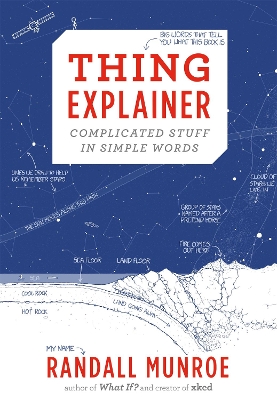This must have been a bitch to edit.
I bought this sight unseen (or asked for it on my xmas list anyway) based on my adoration for his first book What If? Thing Explainer is much shorter - only 60 pages - and the concept is very cool; explain how some of the most common things work.
What I didn't realise is that Munroe went into this book determined to use only the "top 10 hundred" words used in the English language (he determined this based on a number of factors, which he explains at the end of the book, in the section where he lists all the words). He explains why he chose to do this at the beginning of the book.
I love the concept and it doesn't sound like that big a deal on the surface of it; until you actually try to read how, say, a dishwasher works and it's titled "Box that Cleans Food Holders" or the page that explains how the "Big Tiny Thing Hitter" works (that's a particle collider to you and I). It's sort of fun trying to figure out what some of the entries are but reading the whole thing becomes rather tedious and ultimately I skimmed through it, reading bits here and there and laughing at the little comic asides that make me such a fan of Munroe. Some of the entries though, would be a great start at explaining some of the easier concepts to small kids (there's an entry for a tree, for example).
I especially love his explanation of the Constitution of the United States. Ultimately, it's a fun book, but I would have loved this book had he written it in this same style, but didn't try to limit himself to just the 1000 most common words (which oddly enough do not include "nine").
